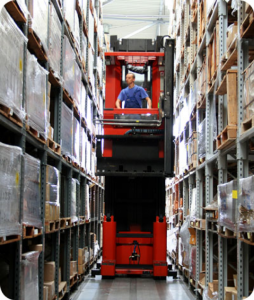
In the world of freezer warehouses, high rise warehouses are very common in Europe. This made H.M. de Jong Koel- en Vrieshuis, a cold storage company in The Netherlands think that a fully automated refrigerated high rise warehouse would be a good option for their business activities.
In a conventional refrigerated warehouse it is possible to store three pallets high, but a high rise warehouse would allow for at least six high. The energy needed to cool a high rise warehouse is also lower than for the conventional warehouse and the fully automated warehouse would only need 5 warehouse employees, much less than in the conventional warehouse. Calculations showed that the high rise option was more interesting than the conventional one.
The new building is 60 feet tall at its highest point and can hold up to 12,500 pallets. The company only uses one third of the surface of a conventional warehouse and is using 40% less energy to refrigerate their products because the warehouse is fully automated and doors remain closed. The warehouse consists of seven refrigerated units, each unit is divided into two compartments to enable products to be stored in fourteen different conditions if needed.
Pallets are put on carriers to transport them between the different areas in the building. The advantage of carriers over a conveyor system is that when a carrier breaks down, it can be pushed aside and the process can continue. When a conveyor system breaks down, everything stops.
Since pallets often have different dimensions, the company developed special standard units to transport pallets through the building: so called “slave boards”. These slave boards are equipped with RFID tags and each pallet is scanned to this tag with a unique barcode. That way the company can locate and follow its products throughout the warehouse. A spokesperson for the company says that they initially chose to work with conventional labels, but calculated that this would be very expensive in the long run. That’s why they decided to go with RFID.
The warehouse has now a capacity of 200 pallet handlings per hours (in or out) or combined 85 pallets in and 145 pallets out. Although the company says that it took a great effort to accomplish this state of the art warehouse, it is satisfied with the results. They expect that fine tuning of the system will continue for at least another year, but the company’s owner says he feels lucky his company is still small, so they can be flexible and make quick decisions: “That’s what’s needed in this process!”

